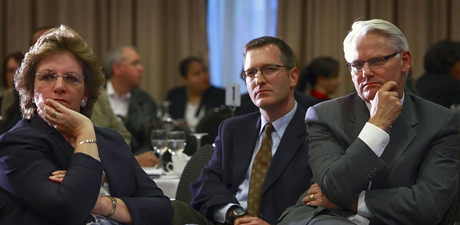
*Story corrected Jan. 14, 2009.
In April 2006, an independent review judged the Campbell administration of having mismanaged the Ministry of Children and Family Development -- which some said contributed to the deaths of two toddlers.
"I don't think there's any doubt" government cutbacks "took the knife too far," concluded former Justice Ted Hughes, the man appointed by Campbell to make sure such a scandal didn't happen again.
But 33 months later, the status of the 62 recommendations included in Hughes' independent review of British Columbia's child protection system is in the doubt.
And Premier Gordon Campbell is again to blame.
Campbell needed to create a clear process and chain of command to right this badly-listing ministry.
Instead, the two powerful child protection officials put in place by his government -- Lesley du Toit, the deputy minister of Children and Family Development, and Mary Ellen Turpel-Lafond, the province's children and youth representative -- have become, in effect, rivals.
This is the back story on the frustrating stand-off between them and their competing visions for the ministry.
South African import
Following the last election, the Campbell administration faced accusations from the media and the opposition that its policies had put vulnerable children at risk -- contributing to the deaths of toddlers Sherry Charlie and Savannah Hall.
In response, the government appointed Hughes in November 2005 to "examine oversight, public reporting and advocacy" within the child protection system.
The problem is the premier didn't stop there.
The Hughes Review, which his government had expected would be "accomplished in the space of a few weeks," took four and a half months.
In the meantime, the premier's office -- anxious to act -- retained then South African child care agency executive director Lesley du Toit to "assist government in developing a response" to that review's yet-to-be-written recommendations.
But du Toit, who would later be named the deputy minister of Children and Family Development, seems to have come to that job with her own vision for the future of the ministry.
Just three months prior to her hiring, she had been in Victoria delivering a presentation to senior bureaucrats and community members entitled "Transforming the Child Welfare System."
Principle or policies?
Du Toit's transformative vision -- which, according to her, was "strongly influenced" by the Hughes Review -- appears at odds with the report's recommendations.
Hughes wanted to repair the ministry, stressing a need for "equilibrium and stability."
By comparison, du Toit's plan is less certain, consisting primarily of principles rather than policies.
But what we do know is that she appears to want to remake rather than just repair the ministry -- changing its culture and structure.
Which could be why du Toit has stated the Hughes Review won't be "used as a blueprint for transformation" -- despite that being Hughes explicit intention.
As a result, implementing his recommendations seems to have become, at best, a secondary consideration for du Toit.
In fact, the new deputy minister's first message to ministry staff included no reference to that review.
Instead, du Toit wrote she had been appointed to "facilitate and accelerate the transformation of the system for children, youth and families in B.C. with which this ministry began some years back."
And that appointment meant the government -- which had also commissioned the Hughes Review -- had created, by accident rather than design, two competing futures for the Ministry of Children and Family Development.
Here comes the judge
But that might not have become apparent if government hadn't followed Hughes' first and foremost recommendation, appointing a children and youth representative to oversee that ministry.
Saskatchewan provincial court judge Mary Ellen Turpel-Lafond assumed that responsibility on April 1, 2006.
And within three months, she was privately expressing concern about the future of the Hughes Review recommendations.
After all, the deputy minister, according to Turpel-Lafond, told her during a meeting that "many of the recommendations were not possible to achieve" because the review was "informed by ideas which are entrenched in an old system."
"I take from this that the Hughes Review recommendations are something that should be left behind in light of transformation," continued the representative, in a letter addressed to du Toit.
In November 2007,* Turpel-Lafond went public with her concerns, stating there is "too little evidence within MCFD of a coordinated effort to implement numerous Hughes recommendations where its leadership is required."
And, last month, she made a similar statement following the release of her second Hughes Review progress report.
Dismissing the Hughes approach?
In the past, the government has attempted to defuse those concerns, with Children and Family Development Minister Tom Christensen assuring the legislature he would be "moving forward with each and every one of Mr. Hughes's recommendations."
In fact, the ministry's Strong, Safe and Supported action plan -- which was released this past April -- included the ministry's own assessment of its progress in responding to the Hughes Review.
But, recently, the government has become dismissive of Turpel-Lafond's criticisms and even, arguably, the review itself.
In response to the representative's latest progress report, Christensen told reporters the government isn't taking an approach "where -- to the letter of each recommendation -- we must be able to satisfy it completely."
Instead, "what we've said is we want to address those recommendations in the context in which they were offered and within our own Strong, Safe and Supported plan."
So, 33 months following the release of the Hughes Review, the government has become entrenched and so has the representative.
Two's a crowd
The representative, who is now seen by government as a critic rather than a watchdog, is convinced "there is still no coordinated effort" within the ministry to implement the review.
Meanwhile, the government seems just as convinced du Toit's vision will meet the overall objective of that review -- improving the "safety and well-being of B.C.'s children, youth and families" -- even if it doesn't specifically respond to all the Hughes Review recommendations.
An impasse of the premier's own creation has been reached.
The Campbell administration was wrong to have appointed both Hughes and du Toit to do what became the same task -- envisioning a future for the Ministry of Children and Family Development.
But the consequences of that decision are more than bureaucratic.
Du Toit's poorly articulated vision may indeed improve the province's child protection system.
But to date, there's little evidence that's the case.
Nor has the representative found any -- perhaps because there is none, perhaps because of her own belief in the Hughes Review.
Meanwhile, many of the review's recommendations have gone unfulfilled -- perhaps because they are unnecessary, perhaps because of the deputy minister's equally strong belief in her own vision.
And, in the end, it is the children who will suffer as a result of this in-fighting.
Related Tyee stories:
- Sherry Charlie reforms dropped: BC youth watchdog
- Gov't Kept Kids in Unsafe Homes Says Watchdog
Children left to live with known abusers; probe planned. - Cody's Death: How Deep an Investigation?
The Fontaine toddler died in a troubled home after social worker cutbacks. But the Liberals killed the Children's Commission -- and its power to investigate government fault. A Tyee special report.
Read more: Rights + Justice, Politics
















Tyee Commenting Guidelines
Comments that violate guidelines risk being deleted, and violations may result in a temporary or permanent user ban. Maintain the spirit of good conversation to stay in the discussion.
*Please note The Tyee is not a forum for spreading misinformation about COVID-19, denying its existence or minimizing its risk to public health.
Do:
Do not: